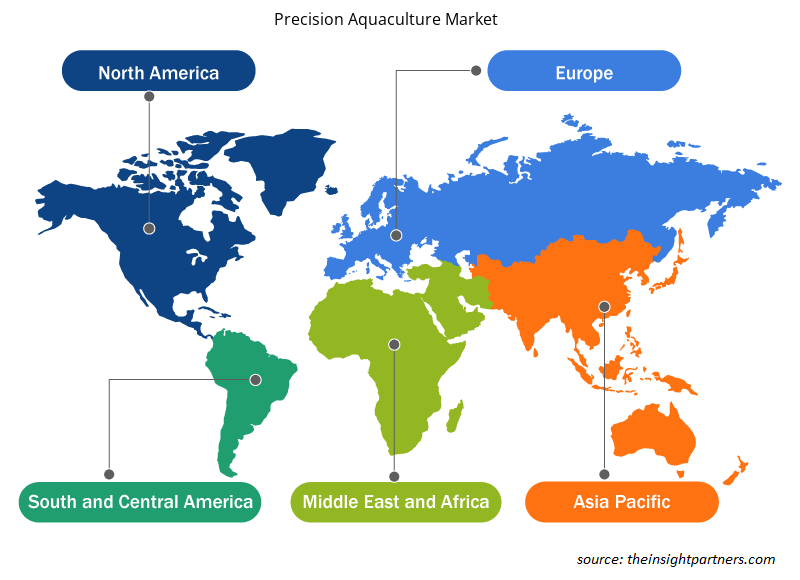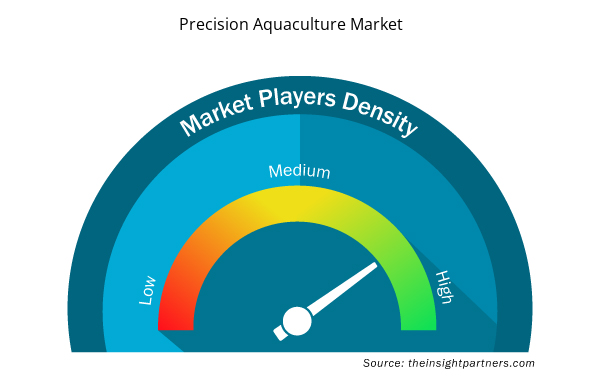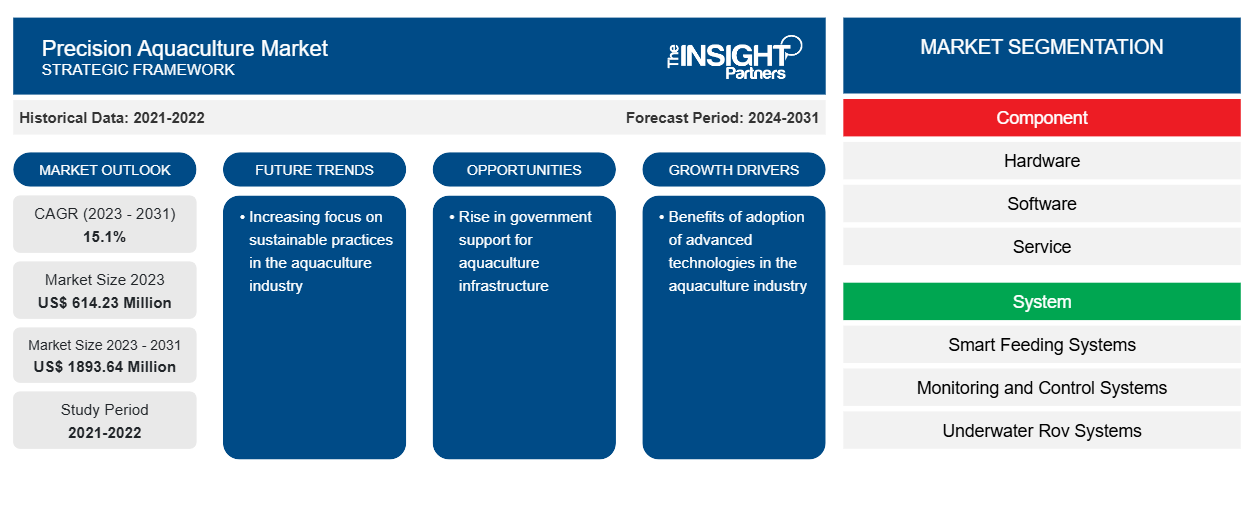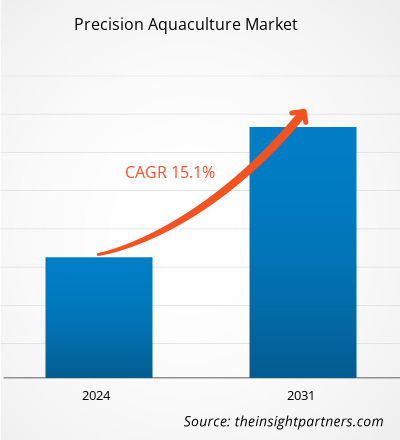Der Markt für Präzisionsaquakultur soll von 614,23 Millionen US-Dollar im Jahr 2023 auf 1893,64 Millionen US-Dollar im Jahr 2031 anwachsen. Der Markt wird zwischen 2023 und 2031 voraussichtlich eine durchschnittliche jährliche Wachstumsrate von 15,1 % verzeichnen. Der Anstieg der Investitionen in die Aquakulturinfrastruktur und die zunehmende Einführung von IoT-Lösungen in der Aquakulturbranche dürften weiterhin wichtige Trends auf dem Markt bleiben.
Präzisions-Aquakultur-Marktanalyse
Der zunehmende Einsatz von KI, IoT und ROV in der Aquakultur ist einer der Hauptfaktoren, die das Marktwachstum vorantreiben. Der wachsende Fokus und die Investitionen der Regierung in die Entwicklung der Aquakulturinfrastruktur treiben das Marktwachstum voran. Der Beitrag präziser Aquakulturtechniken zur nachhaltigen Meeresfrüchteproduktion und zur Befriedigung der weltweiten Nachfrage nach Wasserprodukten treibt das Marktwachstum weiter an.
Marktübersicht zur Präzisionsaquakultur
Die Aquakulturindustrie erlebt in großem Umfang den Einsatz von Geräten des Internets der Dinge (IoT), um ihre Farmen zu modernisieren und datengesteuerte Entscheidungen zu treffen. Die Präzisionsaquakultur nutzt vernetzte Sensoren und Software in der Meeresumwelt, um Aquafarmbetriebe zu überwachen, zu analysieren, zu interpretieren und Entscheidungshilfen bereitzustellen. Das datenbasierte Aquakultursystem hilft den Betreibern der Aquaindustrie, ihre Produktivität zu steigern.
Passen Sie diesen Bericht Ihren Anforderungen an
Sie erhalten kostenlose Anpassungen an jedem Bericht, einschließlich Teilen dieses Berichts oder einer Analyse auf Länderebene, eines Excel-Datenpakets sowie tolle Angebote und Rabatte für Start-ups und Universitäten.
- Holen Sie sich die wichtigsten Markttrends aus diesem Bericht.Dieses KOSTENLOSE Beispiel umfasst eine Datenanalyse von Markttrends bis hin zu Schätzungen und Prognosen.
Treiber und Chancen des Marktes für Präzisionsaquakultur
Vorteile der Einführung fortschrittlicher Technologien in der Aquakulturindustrie zur Förderung des Marktes
Die Aquakulturbranche steht vor Herausforderungen wie steigenden Futter- und Energiekosten, Umweltbedrohungen, Produktionsineffizienzen und anderen. Um diese Herausforderungen zu bewältigen, verwendet die Branche Sensoren, Kameras, künstliche Intelligenz, Cloud-Technologien und verschiedene andere Lösungen, um auf der Grundlage der Daten beispiellose Erkenntnisse zu gewinnen, was zu einem Wachstum des Marktes für Präzisionsaquakultur führt. Darüber hinaus bieten die Marktteilnehmer den Marktteilnehmern der Aquakulturbranche Lösungen an. Beispielsweise helfen die Präzisionsaquakulturtechnologien von Innovasea Aquakulturbetreibern, ihre Abläufe auf der Grundlage zuverlässiger Echtzeitdaten genau zu überwachen, zu verwalten und zu kontrollieren. Sie helfen den Betreibern bei der besseren Entscheidungsfindung, um ihre Gewinne zu steigern und nachhaltiger zu werden.Innovasea’s precision aquaculture technologies help aquaculture operators to closely monitor, manage and control their operations based on reliable real-time data. It helps the operators with better decision-making to boost profits and become more sustainable.
Steigende staatliche Unterstützung für Aquakultur-Infrastruktur
Der zunehmende Trend zum intelligenten Fischfang und das Wachstum im Fischhandel erhöhen die Nachfrage nach Produkten, die für den Aufbau der Aquakulturinfrastruktur erforderlich sind. Veränderungen im weltweiten Lebensmittelkonsum tragen ebenfalls zur Expansion und Diversifizierung dieser Branche bei. Darüber hinaus treiben das Wachstum des Einzelhandels und die leichte Verfügbarkeit von Aquakulturprodukten über zahlreiche Kanäle den Verkauf dieser Produkte an. Das kräftige und kontinuierliche Wachstum der Aquakultur in verschiedenen bedeutenden Ländern wie Norwegen, China, Indien und Indonesien treibt den globalen Markt für Präzisionsaquakultur an.
Segmentierungsanalyse des Marktberichts zur Präzisionsaquakultur
Wichtige Segmente, die zur Ableitung der Marktanalyse für Präzisionsaquakultur beigetragen haben, sind Komponente, System und Anwendung.
- Basierend auf den Komponenten ist der Markt für Präzisionsaquakultur in Hardware, Software und Service unterteilt. Das Hardwaresegment hatte im Jahr 2023 den größten Marktanteil.
- Nach System ist der Markt in intelligente Fütterungssysteme, Überwachungs- und Kontrollsysteme, Unterwasser-Rov-Systeme und andere unterteilt. Die intelligenten Fütterungssysteme hielten im Jahr 2023 einen erheblichen Marktanteil.Rov systems, and others. The smart feeding systems held a significant share of the market in 2023.
- Nach Anwendung ist der Markt in Betrugserkennung und -prävention, Governance Risk & Compliance (GRC), Customer Experience Management, vorausschauende Wartung, Supply Chain Management, Bedrohungsinformationen und andere unterteilt. Das Customer Experience Management hatte im Jahr 2023 einen erheblichen Marktanteil.GRC), customer experience management, predictive maintenance, supply chain management, threat intelligence, and others. The customer experience management held a significant share of the market in 2023.
Marktanteilsanalyse für Präzisionsaquakultur nach geografischer Lage
Der geografische Umfang des Marktberichts zur Präzisionsaquakultur ist hauptsächlich in fünf Regionen unterteilt: Nordamerika, Asien-Pazifik, Europa, Naher Osten und Afrika sowie Süd- und Mittelamerika.
Europa wird im Prognosezeitraum voraussichtlich eine signifikante durchschnittliche jährliche Wachstumsrate aufweisen. Der Anstieg der Digitalisierung und die wachsende Nachfrage nach fortschrittlichen Datenanalysetechniken in der Region treiben das Marktwachstum an. Darüber hinaus treibt der staatliche Fonds zur Förderung der Aquakulturindustrie den Markt an. Beispielsweise zielt der EU-Fonds „Horizon 2020“ auf eine nachhaltige Intensivierung der Aquakultur in Europa ab. Das vom EU-Fonds „Horizon 2020“ finanzierte GAIN-Projekt konzentriert sich auf Präzisionsaquakultur.CAGR in the forecast period. The rise in digitalization and growing demand for advanced data analytics techniques in the region is driving market growth. In addition, the government fund to fuel the aquaculture industry drives the market. For example, the EU Horizon 2020 Fund aimed at sustainable aquaculture intensification in Europe. The GAIN project funded by the EU Horizon 2020 Fund is focused on precision aquaculture.
Regionale Einblicke in den Markt für Präzisionsaquakultur
Die regionalen Trends und Faktoren, die den Markt für Präzisionsaquakultur im Prognosezeitraum beeinflussen, wurden von den Analysten von Insight Partners ausführlich erläutert. In diesem Abschnitt werden auch die Marktsegmente und die Geografie des Marktes für Präzisionsaquakultur in Nordamerika, Europa, im asiatisch-pazifischen Raum, im Nahen Osten und Afrika sowie in Süd- und Mittelamerika erörtert.

- Erhalten Sie regionalspezifische Daten zum Markt für Präzisionsaquakultur
Umfang des Marktberichts zur Präzisionsaquakultur
| Berichtsattribut | Details |
|---|---|
| Marktgröße im Jahr 2023 | 614,23 Millionen US-Dollar |
| Marktgröße bis 2031 | 1893,64 Millionen US-Dollar |
| Globale CAGR (2023 - 2031) | 15,1 % |
| Historische Daten | 2021-2022 |
| Prognosezeitraum | 2024–2031 |
| Abgedeckte Segmente | Nach Komponente
|
| Abgedeckte Regionen und Länder | Nordamerika
|
| Marktführer und wichtige Unternehmensprofile |
|
Dichte der Marktteilnehmer für Präzisionsaquakultur: Die Auswirkungen auf die Geschäftsdynamik verstehen
Der Markt für Präzisionsaquakultur wächst rasant, angetrieben durch die steigende Nachfrage der Endnutzer aufgrund von Faktoren wie sich entwickelnden Verbraucherpräferenzen, technologischen Fortschritten und einem größeren Bewusstsein für die Vorteile des Produkts. Mit steigender Nachfrage erweitern Unternehmen ihr Angebot, entwickeln Innovationen, um die Bedürfnisse der Verbraucher zu erfüllen, und nutzen neue Trends, was das Marktwachstum weiter ankurbelt.
Die Marktteilnehmerdichte bezieht sich auf die Verteilung der Firmen oder Unternehmen, die in einem bestimmten Markt oder einer bestimmten Branche tätig sind. Sie gibt an, wie viele Wettbewerber (Marktteilnehmer) in einem bestimmten Marktraum im Verhältnis zu seiner Größe oder seinem gesamten Marktwert präsent sind.
Die wichtigsten auf dem Markt für Präzisionsaquakultur tätige Unternehmen sind:
- AKVA GRUPPE
- Skala AQ
- CHETU INC
- TIEFENTREKKER
- INNOVASEA-SYSTEME
- PENTAIR AES
Haftungsausschluss : Die oben aufgeführten Unternehmen sind nicht in einer bestimmten Reihenfolge aufgeführt.

- Überblick über die wichtigsten Akteure auf dem Markt für Präzisionsaquakultur
Neuigkeiten und aktuelle Entwicklungen zum Markt für Präzisionsaquakultur
Der Markt für Präzisionsaquakultur wird durch die Erhebung qualitativer und quantitativer Daten nach Primär- und Sekundärforschung bewertet, die wichtige Unternehmensveröffentlichungen, Verbandsdaten und Datenbanken umfasst. Nachfolgend sind einige der Entwicklungen auf dem Markt für Präzisionsaquakultur aufgeführt:
- Innovasea, ein weltweit führender Anbieter technologisch fortschrittlicher Lösungen für die Aquakultur und Fischverfolgung, gab bekannt, dass es der chilenischen Aquakulturindustrie nun landgestützte Aquakulturlösungen anbietet. (Quelle: Innovasea, Pressemitteilung, April 2024)
- Skretting Southern Europe hat 360+ auf den Markt gebracht, das bahnbrechende Präzisionslandwirtschaftskonzept, das Fütterungsprotokolle und Produktionsmanagement optimiert und so die Wettbewerbsfähigkeit der mediterranen Aquakultur weiter steigert. Skretting 360+ nutzt die neueste Analysesoftware und andere Industrie 4.0-Technologien, um die Fischproduktion innovativ zu gestalten. Es ist ein Komplettpaket aus präzisionsbasierten Werkzeugen und Dienstleistungen, das Ernährung, Farmmanagementpraktiken und technischen Support sowie hochmoderne Unterwasserkameras und Sensorausrüstung (IoT) umfasst. (Quelle: Skretting, Pressemitteilung, April 2023)
Marktbericht zur Präzisionsaquakultur – Abdeckung und Ergebnisse
Der Bericht „Marktgröße und Prognose für Präzisionsaquakultur (2021–2031)“ bietet eine detaillierte Analyse des Marktes, die die folgenden Bereiche abdeckt:
- Marktgröße und Prognose für Präzisionsaquakultur auf globaler, regionaler und Länderebene für alle wichtigen Marktsegmente, die im Rahmen des Berichts abgedeckt sind
- Markttrends im Bereich der Präzisionsaquakultur sowie Marktdynamiken wie Treiber, Beschränkungen und wichtige Chancen
- Detaillierte PEST/Porters Five Forces- und SWOT-Analyse
- Marktanalyse für Präzisionsaquakultur, die wichtige Markttrends, globale und regionale Rahmenbedingungen, wichtige Akteure, Vorschriften und aktuelle Marktentwicklungen umfasst
- Branchenlandschaft und Wettbewerbsanalyse, einschließlich Marktkonzentration, Heatmap-Analyse, prominenten Akteuren und aktuellen Entwicklungen für den Markt für Präzisionsaquakultur
- Detaillierte Firmenprofile
- Historische Analyse (2 Jahre), Basisjahr, Prognose (7 Jahre) mit CAGR
- PEST- und SWOT-Analyse
- Marktgröße Wert/Volumen – Global, Regional, Land
- Branche und Wettbewerbsumfeld
- Excel-Datensatz


- Electronic Signature Software Market
- Precast Concrete Market
- Single Pair Ethernet Market
- Antibiotics Market
- HVAC Sensors Market
- Intraoperative Neuromonitoring Market
- Clear Aligners Market
- Water Pipeline Leak Detection System Market
- Transdermal Drug Delivery System Market
- Machine Condition Monitoring Market

Report Coverage
Revenue forecast, Company Analysis, Industry landscape, Growth factors, and Trends

Segment Covered
This text is related
to segments covered.

Regional Scope
North America, Europe, Asia Pacific, Middle East & Africa, South & Central America

Country Scope
This text is related
to country scope.
Häufig gestellte Fragen
The estimated value of the precision aquaculture market will be US$ 1893.64 million by 2031.
AKVA GROUP, Scale AQ, CHETU INC, DEEP TREKKER, INNOVASEA SYSTEMS, PENTAIR AES, SOLVAY, Aquabyte, XYLEM INC, and ERUVAKA TECHNOLOGY are some of the key players operating in the precision aquaculture market.
Increasing focus on sustainable practices in the aquaculture industry is considered a key trend in the precision aquaculture market.
The rise in investment for the aquaculture infrastructure and surging adoption of IoT solutions in the aquaculture industry are the key driving factors impacting the precision aquaculture market.
The global precision aquaculture market is estimated to register a CAGR of 15.1% during the forecast period 2023–2031.
Trends and growth analysis reports related to Technology, Media and Telecommunications : READ MORE..
The Insight Partners performs research in 4 major stages: Data Collection & Secondary Research, Primary Research, Data Analysis and Data Triangulation & Final Review.
- Data Collection and Secondary Research:
As a market research and consulting firm operating from a decade, we have published and advised several client across the globe. First step for any study will start with an assessment of currently available data and insights from existing reports. Further, historical and current market information is collected from Investor Presentations, Annual Reports, SEC Filings, etc., and other information related to company’s performance and market positioning are gathered from Paid Databases (Factiva, Hoovers, and Reuters) and various other publications available in public domain.
Several associations trade associates, technical forums, institutes, societies and organization are accessed to gain technical as well as market related insights through their publications such as research papers, blogs and press releases related to the studies are referred to get cues about the market. Further, white papers, journals, magazines, and other news articles published in last 3 years are scrutinized and analyzed to understand the current market trends.
- Primary Research:
The primarily interview analysis comprise of data obtained from industry participants interview and answers to survey questions gathered by in-house primary team.
For primary research, interviews are conducted with industry experts/CEOs/Marketing Managers/VPs/Subject Matter Experts from both demand and supply side to get a 360-degree view of the market. The primary team conducts several interviews based on the complexity of the markets to understand the various market trends and dynamics which makes research more credible and precise.
A typical research interview fulfils the following functions:
- Provides first-hand information on the market size, market trends, growth trends, competitive landscape, and outlook
- Validates and strengthens in-house secondary research findings
- Develops the analysis team’s expertise and market understanding
Primary research involves email interactions and telephone interviews for each market, category, segment, and sub-segment across geographies. The participants who typically take part in such a process include, but are not limited to:
- Industry participants: VPs, business development managers, market intelligence managers and national sales managers
- Outside experts: Valuation experts, research analysts and key opinion leaders specializing in the electronics and semiconductor industry.
Below is the breakup of our primary respondents by company, designation, and region:

Once we receive the confirmation from primary research sources or primary respondents, we finalize the base year market estimation and forecast the data as per the macroeconomic and microeconomic factors assessed during data collection.
- Data Analysis:
Once data is validated through both secondary as well as primary respondents, we finalize the market estimations by hypothesis formulation and factor analysis at regional and country level.
- Macro-Economic Factor Analysis:
We analyse macroeconomic indicators such the gross domestic product (GDP), increase in the demand for goods and services across industries, technological advancement, regional economic growth, governmental policies, the influence of COVID-19, PEST analysis, and other aspects. This analysis aids in setting benchmarks for various nations/regions and approximating market splits. Additionally, the general trend of the aforementioned components aid in determining the market's development possibilities.
- Country Level Data:
Various factors that are especially aligned to the country are taken into account to determine the market size for a certain area and country, including the presence of vendors, such as headquarters and offices, the country's GDP, demand patterns, and industry growth. To comprehend the market dynamics for the nation, a number of growth variables, inhibitors, application areas, and current market trends are researched. The aforementioned elements aid in determining the country's overall market's growth potential.
- Company Profile:
The “Table of Contents” is formulated by listing and analyzing more than 25 - 30 companies operating in the market ecosystem across geographies. However, we profile only 10 companies as a standard practice in our syndicate reports. These 10 companies comprise leading, emerging, and regional players. Nonetheless, our analysis is not restricted to the 10 listed companies, we also analyze other companies present in the market to develop a holistic view and understand the prevailing trends. The “Company Profiles” section in the report covers key facts, business description, products & services, financial information, SWOT analysis, and key developments. The financial information presented is extracted from the annual reports and official documents of the publicly listed companies. Upon collecting the information for the sections of respective companies, we verify them via various primary sources and then compile the data in respective company profiles. The company level information helps us in deriving the base number as well as in forecasting the market size.
- Developing Base Number:
Aggregation of sales statistics (2020-2022) and macro-economic factor, and other secondary and primary research insights are utilized to arrive at base number and related market shares for 2022. The data gaps are identified in this step and relevant market data is analyzed, collected from paid primary interviews or databases. On finalizing the base year market size, forecasts are developed on the basis of macro-economic, industry and market growth factors and company level analysis.
- Data Triangulation and Final Review:
The market findings and base year market size calculations are validated from supply as well as demand side. Demand side validations are based on macro-economic factor analysis and benchmarks for respective regions and countries. In case of supply side validations, revenues of major companies are estimated (in case not available) based on industry benchmark, approximate number of employees, product portfolio, and primary interviews revenues are gathered. Further revenue from target product/service segment is assessed to avoid overshooting of market statistics. In case of heavy deviations between supply and demand side values, all thes steps are repeated to achieve synchronization.
We follow an iterative model, wherein we share our research findings with Subject Matter Experts (SME’s) and Key Opinion Leaders (KOLs) until consensus view of the market is not formulated – this model negates any drastic deviation in the opinions of experts. Only validated and universally acceptable research findings are quoted in our reports.
We have important check points that we use to validate our research findings – which we call – data triangulation, where we validate the information, we generate from secondary sources with primary interviews and then we re-validate with our internal data bases and Subject matter experts. This comprehensive model enables us to deliver high quality, reliable data in shortest possible time.


 Holen Sie sich ein kostenloses Muster für diesen Bericht
Holen Sie sich ein kostenloses Muster für diesen Bericht